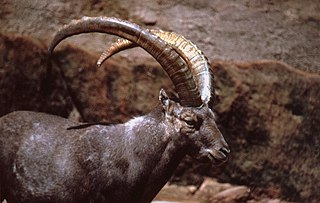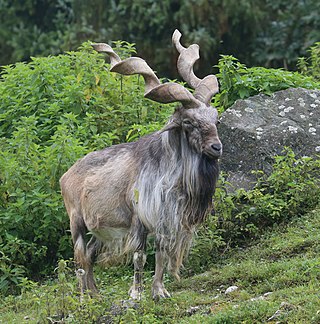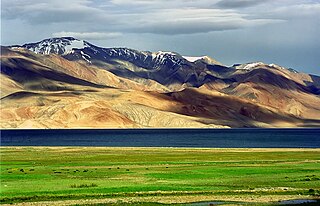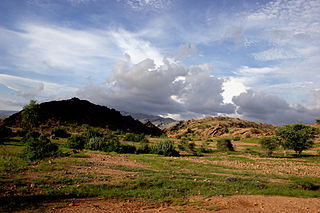Related Research Articles

An ibex is any of several species of wild goat , distinguished by the male's large recurved horns, which are transversely ridged in front. Ibex are found in Eurasia, North Africa and East Africa.

The urial, also known as arkars, shapo, or shapu, is a wild sheep native to Central and South Asia. It is listed as Vulnerable on the IUCN Red List.

Capra is a genus of mammals, the goats, comprising ten species, including the markhor and several species known as ibexes. The domestic goat is a domesticated species derived from the bezoar ibex. It is one of the oldest domesticated species of animal - according to archaeological evidence its earliest domestication occurred in Iran at 10,000 calibrated calendar years ago.

The markhor is a large wild Capra (goat) species native to South Asia and Central Asia, mainly within Pakistan, the Karakoram range, parts of Afghanistan, and the Himalayas. It is listed on the IUCN Red List as Near Threatened since 2015.

Northern Pakistan is a tourism region in northern and north-western parts of Pakistan, comprising the administrative units of Gilgit-Baltistan, Azad Kashmir, Khyber Pakhtunkhwa, Islamabad Capital Territory and the Rawalpindi Division in Punjab. The first two territories are a part of the wider Kashmir region. It is a mountainous region straddling the Himalayas, Karakoram and the Hindu Kush mountain ranges, containing many of the highest peaks in the world and some of the longest glaciers outside polar regions. Northern Pakistan accounts for a high level of Pakistan's tourism industry.

The Marco Polo sheep is a subspecies of argali sheep, named after Marco Polo. Their habitat are the mountainous regions of Central Asia. Marco Polo sheep are distinguishable mostly by their large size and spiraling horns. Their conservation status is "near threatened" and efforts have been made to protect their numbers and keep them from being hunted. It has also been suggested that crossing them with domestic sheep could have agricultural benefits.
The Naltar Wildlife Sanctuary is a protected area located in the Naltar Valley near Nomal, in Gilgit-Baltistan, Pakistan. The sanctuary was created on 22 November 1975 and consists of a steep-sided forested valley with high mountains on either side. The sanctuary is home to a number of large mammals, including a small number of Astor markhor.
Afghanistan has long been known for diverse wildlife. Many of the larger mammals in the country are categorized by the International Union for Conservation of Nature as globally threatened. These include the snow leopard, Marco Polo sheep, Siberian musk deer, markhor, urial, and the Asiatic black bear. Other species of interest are the ibex, the gray wolf, and the brown bear, striped hyenas, and numerous bird of prey species. Most of the Marco Polo sheep and ibex are being poached for food, whereas wolves, snow leopards and bears are being killed for damage prevention.

The Siberian ibex, also known using regionalized names including Altai ibex,Asian ibex, Central Asian ibex, Gobi ibex, Himalayan ibex, Mongolian ibex or Tian Shan ibex, is a polytypic species of ibex, a wild relative of goats and sheep. It lives in Central Asia, and is, by far, the most widely-distributed species in the genus Capra. In terms of population stability, Siberian ibex are currently ranked as Near Threatened, mostly due to over-hunting, low densities and overall decline; still, reliable data is minimal and difficult to come by, in addition to the animals’ expansive natural range, so accurate observations are still scant. The Siberian ibex has, formerly, been treated as a subspecies of the Eurasian Alpine ibex, and whether or not it is a single species or a complex of distinct units that stand out as genetically-distinct is still not entirely clear. The Siberian ibex is the longest and heaviest member of the genus Capra, though its shoulder height is slightly surpassed by the markhor.

Chitral Gol National Park is one of the National Parks of Pakistan. It is located in Lower Chitral District in Khyber-Pakhtunkhwa province of Pakistan beside the Chitral River, at a distance of two hours drive from Chitral town. The park is also known as Chitral National Park.
Dashkin is a village in Astore, Pakistan. It is 85 km from Gilgit, the capital of Gilgit-Baltistan. It has over 5,000 inhabitants, primarily farmers and herdsmen.

The wildlife of Pakistan comprises a diverse flora and fauna in a wide range of habitats from sea level to high elevation areas in the mountains, including 195 mammal, 668 bird species and more than 5000 species of Invertebrates. This diverse composition of the country's fauna is associated with its location in the transitional zone between two major zoogeographical regions, the Palearctic, and the Oriental. The northern regions of Pakistan, which include Khyber Pakhtunkhwa and Gilgit Baltistan include portions of two biodiversity hotspot, Mountains of Central Asia and Himalayas.

The Sindh ibex or Turkman wild goat is a vulnerable subspecies of wild goat endemic to southwest Pakistan, and southeast Iran.
The Astor markhor or flare-horned markhor is a subspecies of the markhor, native to Kashmir and northern Pakistan. To the west it reaches the easternmost parts of Afghanistan. The range of the Astor markhor is very scattered. At one time considered an "endangered species", conservation efforts have had some success and the largest subpopulation in Pakistan may now exceed 1000 individuals. As a result, the International Union for Conservation of Nature has rated its status as "near-threatened".

Pakistan's native fauna reflect its varied climatic zones. The northern Pakistan, which includes Khyber Pakhtunkhwa and Gilgit Baltistan, has portions of two biodiversity hotspots, Mountains of Central Asia and Himalayas.
Mizri Ghar at 3,111 metres (10,207 ft) is the third highest mountain in the Sulaiman Mountains of Western Pakistan. The only peaks higher are Qaisaghar (Kaisargarh) at 3,444 metres (11,299 ft) and Takht-i-Sulaiman at 3,378 metres (11,083 ft). Mizri Ghar is located in Sub-Tehsil Zimri Palaseen of District Musakhail, Balochistan. In summer, Mizri Ghar receives a high amount of rainfall while in winter season it receives a considerable amount of snowfall, sometimes 4 to 5 ft. Its climate is very cool even in summer and its temperature is comparable to Naran, Kaghan, and Murree. This climate uniqueness of Mizri Ghar makes it one of the coldest tourist points in Baluchistan and makes it attractive for the tourists of the adjoining areas such as Zhob, Loralai, D I Khan, DG Khan, and even Multan.

The Karakoram-West Tibetan Plateau alpine steppe is a montane grasslands and shrublands ecoregion found in parts of Pakistan, China, Afghanistan, and India.

The Kirthar National Park is situated in the Kirthar Mountains in Jamshoro District in Sindh, Pakistan. It was established in 1974 and encompasses over 3,087 km2 (1,192 sq mi), making it the third largest national park in Pakistan. Wildlife in the park comprises leopard, striped hyena, Indian wolves, honey badger, urial, chinkara gazelles and rare Sindh ibex. Blackbuck are kept in enclosures for a reintroduction project.
In Afghanistan, there are more than 3,000 plant species, including many assortments of trees, bushes, vines, blossoms, and growths. Especially numerous are therapeutic plants such as wormwood, and asafetida; products of the soil trees are found in numerous territories. Fauna found in the region includes the fox, lynx, wild hound, bear, mongoose, vixen, hedgehog, hyena, jerboa, rabbit, and wild assortments of felines, asses, mountain goats, and mountain sheep. Trout is the most common fish. There are over 100 species of wildfowl and other birds.

The Kashmir markhor, Pir Panjal markhor, or flare-horned markhor is a possible subspecies of Capra falconeri endemic to the Western Himalayas of India and Pakistan. Many, including the IUCN, do not consider it a separate subspecies.
References
- ↑ "Pakistan, big game trophy hunting, markhor, astor, sulaiman, suleman, kashmir, blue sheep, ibex, himalayan, sindh, urial, blandford, afghan, punjab, wild boar driven hunts". Pakistanguides.com. Retrieved 2023-08-19.
- ↑ Babar Khan (25 March 2021). "The story behind why Gilgit-Baltistan allows trophy hunting". Tribune.com.pk. Retrieved 2023-08-19.
- ↑ "TROPHY HUNTING \ ESPECIALLY IN PAKISTAN wildlife(1)". Slideshare.net. Retrieved 2023-08-19.
- ↑ "A review of community-based trophy hunting programs in Pakistan". IUCN. Retrieved 2023-08-19.
- ↑ "Pakistan fetches record-high revenue through markhor trophy hunting". Thenews.com.pk. 2021-11-05. Retrieved 2023-08-19.
- ↑ Shahid, Jamal (March 14, 2021). "Private operators misusing trophy hunting scheme". DAWN.COM.
- ↑ "Trophy hunting in Pakistan: American hunter Bryan Kinsel Harlan paid $110K to kill a rare mountain goat". The Washington Post. Retrieved 2023-08-19.